Sunderland Tramways Company
History
The Sunderland Tramways Company, which was established in 1877, obtained powers to construct a standard-gauge horse tramway system the following year, commencing services on the 28th April 1879. The first line ran northeastwards from Monkwearmouth to Roker, and was joined on the 11th June 1879 by further lines, the main route running southwards across the River Weir, along Bridge St, Fawcett St and Burdon Rd to Christ Church (now the Guru Gobind Singh Sikh Temple), where it turned eastwards along Gray Rd, northwards along Tatham St to its junction with Borough Rd, and thence back into the town, with a branch eastwards from the latter junction to the Docks (Adelaide St).
The system was expanded further courtesy of Sunderland Corporation, who obtained powers for construct extensions to the existing tramway in 1879. These were opened between the 18th June 1880 and the 1st January 1881, but as municipal authorities were not permitted to operate tramways themselves — by the Tramways Act of 1870 — they were leased to the STCo. The first new line ran east to west from the junction of Villiers St and High St, along High St for its entire length, then up Silksworth Row and Hylton Rd to Peacock St; the second line, also running east to west, but further south, ran from the junction of Fawcett St and Holme St, along Holmeside and Vine Place to the western end of Albion Place near the Royal Infirmary; whilst the third new line, which was on the north bank of the River Weir, ran roughly westwards from the STCo's line at the Wheatsheaf to Southwick. This brought the system to its final size of circa 7.2 miles, 3.54 miles of which were owned by the STCo.
The STCo experimented unsuccessfully with steam traction between 1880 and 1881, not only having problems with the engines, but also with a vociferous anti-tram lobby. The company struggled to turn a profit in the early years, but the appointment of an experienced tramway manager in 1882 led to a dramatic turnaround, the company thenceforward paying its shareholders very respectable dividends.
In 1894, the company attempted to interest the corporation in expanding the system, but naturally wanted to secure any investment it made by getting the corporation to defer its right to buy the undertaking (an option it had under the 1870 Tramways Act from the 16th August 1899), and to give the company a blanket 21-year lease. The corporation came within a whisker of accepting the proposal, but in the end declined, beginning the long process of deciding what sort of tramway it wanted to build (namely, the method of traction, and the routes), as well as whether it wished to operate it or lease it. On the 11th January 1899, the council formally decided to seek the necessary powers to build and operate an overhead electric system, and to serve the STCo with six months' notice of its intention to purchase on the 16th August 1899.
The corporation's bill duly received its Royal Assent on the 1st August 1899, and after some hard negotiating with the STCo, it purchased the undertaking on the 26th March 1900, taking over operation on the 30th. The first electric service ran on the 15th August 1900, with the last horse service running six months later on the 19th February 1901.
Uniforms
Several photos exist of the earliest months of the horse tramway’s existence (in 1879), and these clearly show that staff wore a variety of informal attire, initially very smart (frock coats or overcoats, with bowler hats), but gradually giving way to more mundane and workmanlike clothing (heavy jackets and flat caps). The use of informal attire was common practice amongst early horse tramway operators, and indeed, many of them never saw fit to change, and thus never issued uniforms or insignia of any kind. The Sunderland Tramways Company did however revise its policy some time in the 1890s, as photos taken around this time show staff wearing kepi-style caps, though probably with self-purchased informal jackets. The caps carried a prominent curved metal badge, which possibly bore the company name and/or the employee’s designation. Unfortunately, no examples are known to have survived, so precise details remain unknown.
Steam tram drivers and conductors appear to have worn similar attire to their horse-tram counterparts.
Photographs of inspectors are unknown, and it is entirely possible that the STCo never made use of them.
Further reading
For a history of Sunderland's tramways, including the horse-drawn era, see: 'Tramways of Sunderland' by S A Staddon; Advertiser Press (1964). A second, and heavily revised edition was published by the Sunderland Echo in 1991.
Images
Horse tram drivers and conductors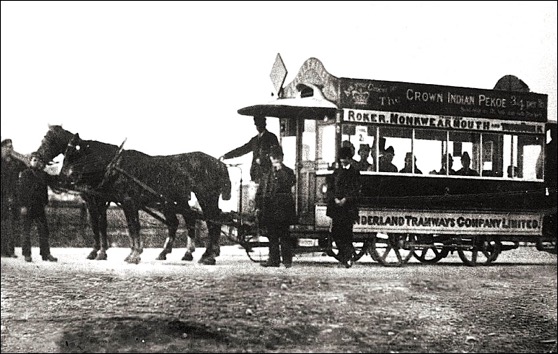
A very prominently marked STCoLtd tramcar (possibly No 2) at the terminus at the eastern end of Harbour View in Roker — probably taken in May 1879, i.e., barely a month after the opening. The driver is wearing smart but informal attire. With thanks to Malcolm Fraser.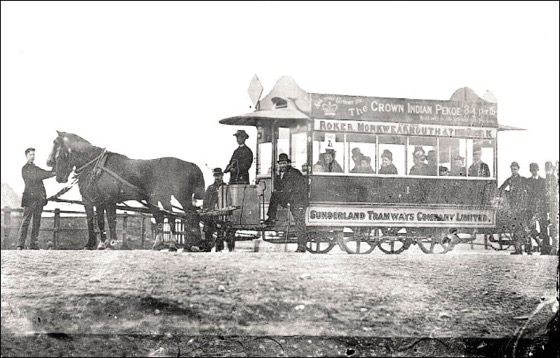
Another shot taken at the same location, and possibly on the same day, this time of Horsecar No 1. The driver appears to be wearing something akin to a stetson! With thanks to Malcolm Fraser.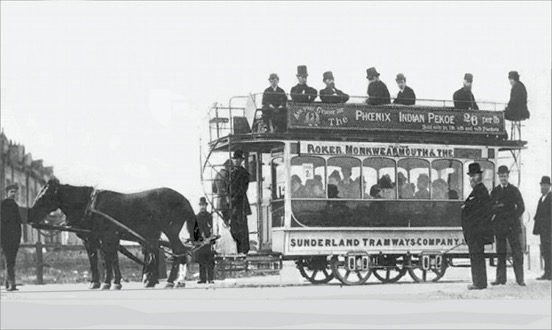
The STCo's first double-deck tram (converted from a single-deck example) on its first journey in 1880. The driver and conductor (second from the right) are both wearing informal attire. With thanks to Malcolm Fraser.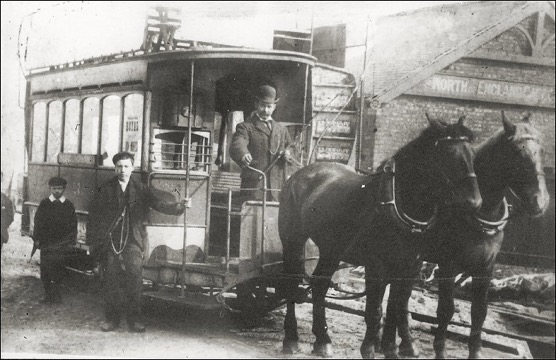
Another view taken at the eastern end of Harbour View, but this time looking east towards the sea — photo possibly taken in the 1880s. With thanks to Malcolm Fraser.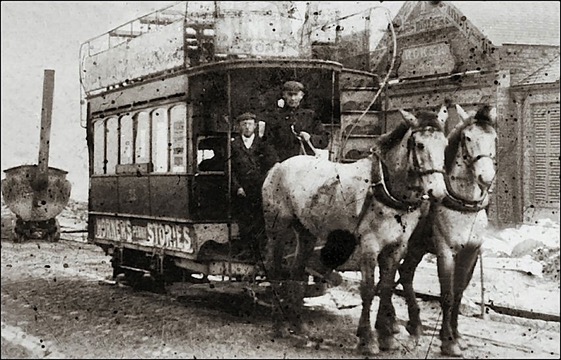
A very similar view to the previous shot, but with the crew looking a good deal less smart (in flat caps) than in the previous photo — undated, but probably taken in the 1890s. With thanks to Malcolm Fraser.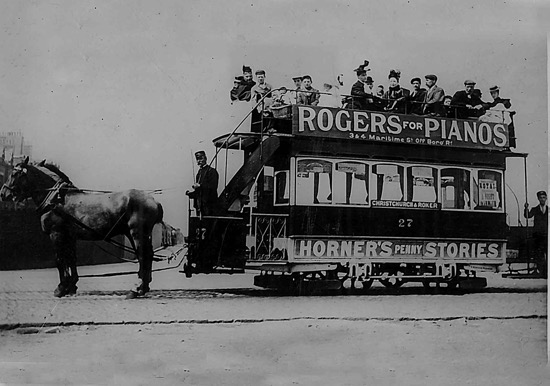
A scene at the terminus at the end of Harbour View showing Tramcar No 27 — photo undated, but probably taken in the 1890s. Both the driver and conductor (extreme right) are wearing kepi-style caps. With thanks to Malcolm Fraser.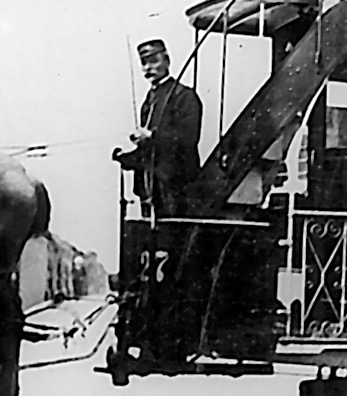
A blow up of the above photo showing the driver's prominent curved cap badge.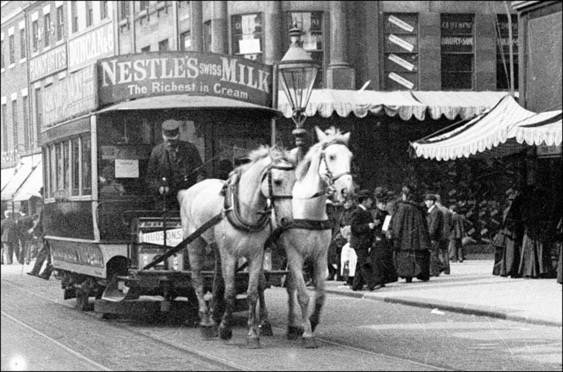
A shot taken in Fawcett St of a horsecar crossing High St West — undated, but probably taken around 1900. With thanks to Malcolm Fraser.
Steam tram drivers and conductors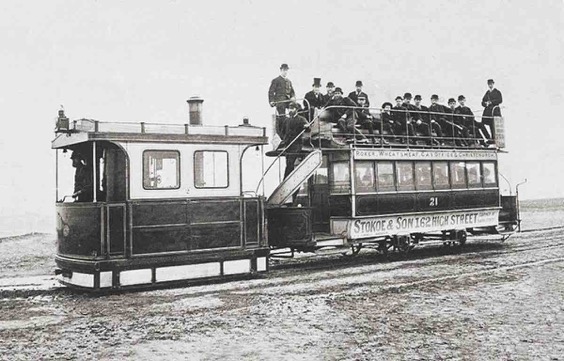
Sunderland Tramways Company Steam Tram No 2, an unusual vehicle assembled by R & W Hawthorn from parts supplied by the Swiss Locomotive and Engine Works, Winterthur — photo possibly taken around December 1880. With thanks to Malcolm Fraser.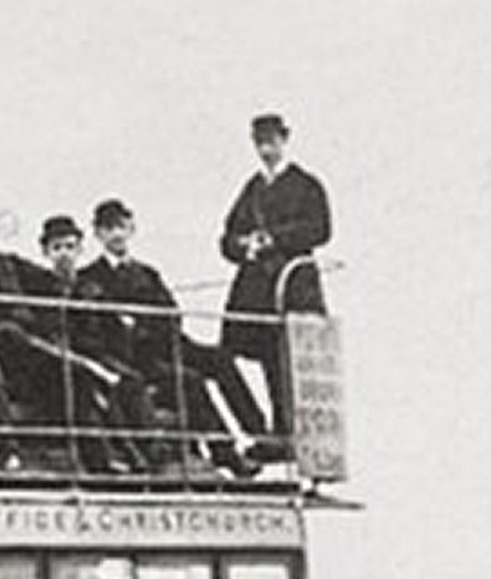
A blow-up of the above photo showing the conductor, who is wearing informal attire.